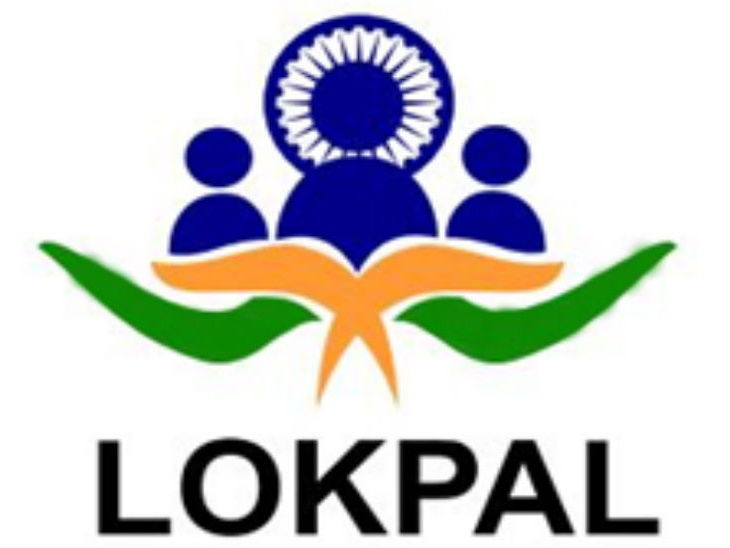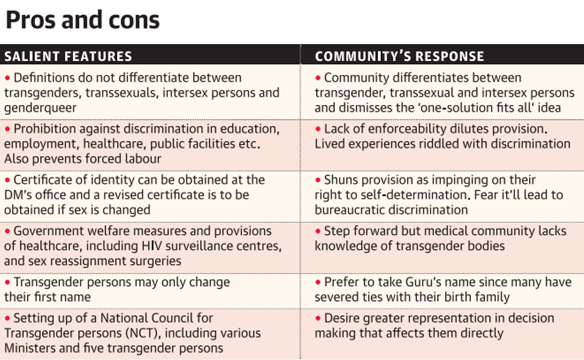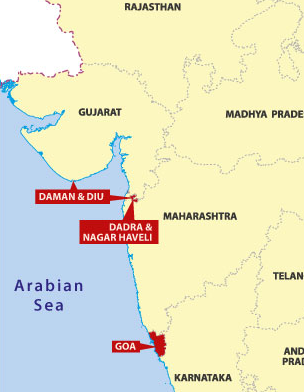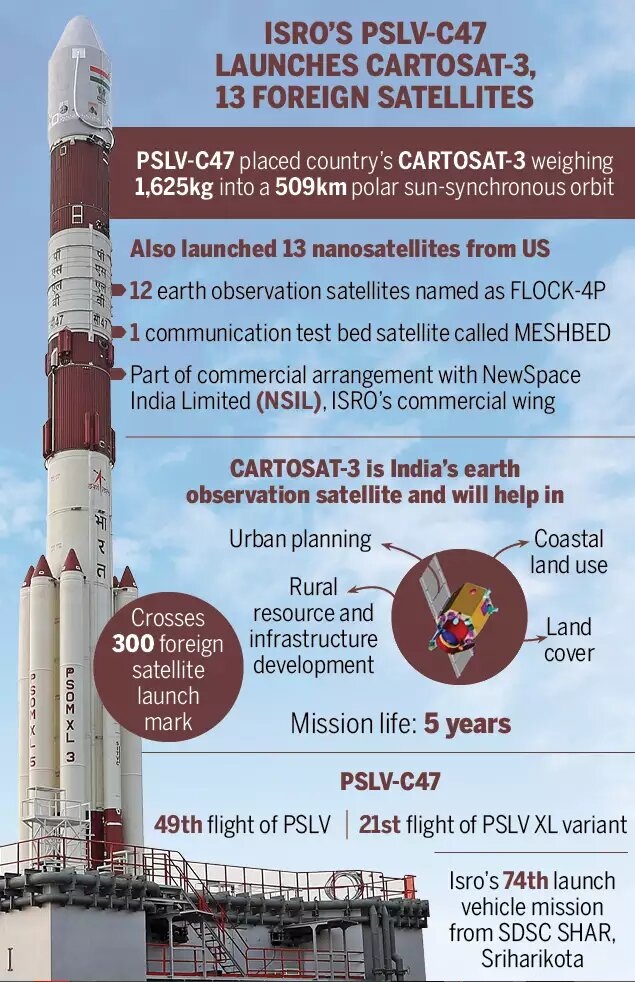Social Justice
The Transgender Persons (Protection of Rights) Bill, 2019
The Parliament passed the Transgender Persons (Protection of Rights) Bill, 2019.
Key Features
- Definition of a transgender person: The Bill defines a transgender person as one whose gender does not match the gender assigned at birth. It includes transmen and trans-women, persons with intersex variations, gender-queers, and persons with socio-cultural identities, such as kinnar and hijra.
- Certificate of identity: A transgender person may make an application to the District Magistrate for a certificate of identity, indicating the gender as ‘transgender’.
- Prohibition against discrimination: The Bill prohibits discrimination against a transgender person, including denial of service or unfair treatment in relation to:
- Education, employment, healthcare.
- Access to or enjoyment of goods, facilities, opportunities available to the public.
- Right to movement, right to reside, rent, or otherwise occupy property.
- Opportunity to hold public or private office.
- Access to a government or private establishment in whose care or custody a transgender person is.
- Health care
- The Bill also seeks to provide rights of health facilities to transgender persons including separate HIV surveillance centres, and sex reassignment surgeries.
- It also states that the government shall review medical curriculum to address health issues of transgender persons, and provide comprehensive medical insurance schemes for them.
- It calls for establishing a National Council for Transgender persons (NCT).
- Punishment: It states that the offences against transgender persons will attract imprisonment between six months and two years, in addition to a fine.
Concerns
- The Bill does not have any provision for self-determination of gender. The transgender community has questioned the certificate of identity.
- It fails to address the lack of an effective mechanism to enforce the legal prohibition against discrimination on the ground of gender identity.
- It does not make provision for affirmative action in employment or education despite the Supreme Court’s mandate in National Legal Services Authority NALSA v. Union of India (UOI) case (2014).
- The Bill sets out lighter sentences for several criminal offences, such as “sexual abuse" and “physical abuse", when they are committed against transgender people.
Indian Economy
Currency Swap Arrangement for SAARC
Why in News
The Reserve Bank of India (RBI) has revised the framework on currency swap arrangement for the South Asian Association for Regional Cooperation (SAARC) countries for 2019-2022.
- This has been done to further financial stability and economic cooperation within the SAARC region.
Key Points
- The SAARC currency swap facility came into operation on 15th November, 2012.
- Under the revised framework,
- The RBI will continue to offer a swap arrangement within the overall corpus of USD 2 billion.
- The swap drawals can be made in US dollar, euro or Indian rupee. The framework provides certain concessions for swap drawals in Indian rupee.
- The facility will be available to all SAARC member countries, subject to their signing the bilateral swap agreements.
- The framework is valid from 14th November, 2019 to 13th November, 2022.
Currency Swap Arrangement
- The word swap means exchange. A currency swap between the two countries is an agreement or contract to exchange currencies with predetermined terms and conditions.
- Central banks and Governments engage in currency swaps with foreign counterparts to meet short term foreign exchange liquidity requirements or to ensure adequate foreign currency to avoid Balance of Payments (BOP) crisis till longer arrangements can be made.
- Example
- India and Japan in the year 2018 signed a bilateral currency swap agreement.
- RBI will get a certain amount of yen and the Bank of Japan will get an equivalent amount in Indian rupees on a decided swap rate.
- After a specified period, both the countries will repay the amount at the same swap rate.
South Asian Association for Regional Cooperation
- SAARC was established with the signing of the SAARC Charter in Dhaka (Bangladesh) on 8th December 1985.
- Eight Member States: Afghanistan, Bangladesh, Bhutan, India, Maldives, Nepal, Pakistan and Sri Lanka.
- Secretariat: Kathmandu (Nepal)
- Objective: To promote the welfare of the people of South Asia and to improve their quality of life, and to accelerate economic growth, among other things.
Indian Polity
Dadra and Nagar Haveli and Daman and Diu (Merger of Union Territories) Bill, 2019
Why in News
Recently, a Bill to merge the Union Territories (UTs) of Daman and Diu (D&D) and Dadra and Nagar Haveli (DNH) has been introduced in the Lok Sabha. It seeks to provide better delivery of services to the citizens of both Union Territories by improving efficiency and reducing paperwork.
Key Points
- Both UTs have two separate constitutional and administrative bodies which lead to a lot of duplicacy, inefficiency and wasteful expenditure.
- The merger will help in achieving the government’s goal to have Minimum Government, Maximum Governance.
- Both of them have small population and limited geographical area so the merger will not be challenging and the services of officers will be used efficiently.
- The move comes after the landmark decision of bifurcating the State of Jammu and Kashmir into the Union Territories of Jammu and Kashmir and Ladakh.
Minimum Government, Maximum Governance
- It is the motto of the central government to achieve a citizen-friendly and accountable administration.
- It aims to bring Government closer to citizens so that they become active participants in the governance process and reduce their time and efforts.
- An important step for Good Governance is the simplification of procedures and processes in the Government so as to make the entire system transparent and faster.
- Identification and repeal of obsolete laws and rules, identification and shortening of various official forms, leveraging technology to bring in transparency in public interface and a robust public grievance redress system are other aspects of it.
Daman and Diu and Dadra and Nagar Haveli
- These two UTs are located in the western region of India.
- Daman and Diu are two widely separated districts situated on the southern side of Gujarat. Daman is an enclave on Gujarat’s southern coast and Diu encompasses an island off the southern coast of Gujarat’s Kathiawar Peninsula. It is in close proximity of the UT of DNH.
- Dadra and Nagar Haveli consists of two separate parts. Dadra is surrounded by the state of Gujarat and Nagar Haveli lies on the borders of Maharashtra and Gujarat.
- Both were colonised by the Portuguese and were liberated in December 1961.
- In 1987, when Goa got statehood, Daman and Diu were made a separate Union Territory from the previous Union Territory of Goa, Daman and Diu.
Science & Technology
Cartosat-3
Why in News
Indian Space Research Organisation (ISRO) has launched Cartosat-3 and 13 commercial nanosatellites into Sun Synchronous orbit from Satish Dhawan Space Centre (SDSC), Sriharikota.
- Cartosat-3 is an earth-observation remote sensing satellite which will replace Indian Remote Sensing (IRS) series. So far, ISRO has orbited 8 Cartosats since 2005.
- Remote sensing is the science of obtaining information about objects or areas from a distance, typically from aircraft or satellites.
- The 13 commercial nanosatellites are from the USA, which is the first commercial order for New Space India Limited, the commercial arm of ISRO which was formed in March 2019.
Key Points
- Cartosat-3 is a third-generation advanced earth observation satellite carried by Polar Satellite Launch Vehicle, PSLV-C47.
- PSLV (Polar Satellite Launch Vehicle) is an indigenously-developed expendable launch system of the ISRO.
- Resolution: It has the 'sharpest eye' of civil remote sensing satellites in the world.
- One of Cartosat-3’s cameras offers a ground resolution of 25 cm - it can pick up an object of a minimum of 25 cm size from a height of around 500 km.
- Currently, a satellite owned by US private company- WorldView-3, has the best ground resolution of 31 cm.
- Weight: At 1,625 kg, Cartosat-3 is unusually heavy and more than double the mass of the previous eight in its class.
- Orbit: PSLV will place Cartosat 3 in an orbit of 509 km.
- Inclination: It has been placed at 97.5 degrees to the equator of the earth.
- It has many new technologies such as a highly agile or flexible camera; high-speed data transmission, advanced computer system, etc.
Applications
- Data from most of the Cartosat satellites are exclusively used by the armed forces.
- However, an existing policy allows only government and government authorised agencies to access ISRO's high-resolution imageries below a resolution of 1 metre.
- Cartosat-3’s optical imaging will also help to detect precise cartographic or mapping activities.
- The imageries are also used for urban and rural infrastructure planning, coastal land use and regulation, utility management such as monitoring road networks, water grids or distribution, creation of land use maps, disaster management, etc.
Cartosat Satellites
- The Cartosat satellites are earth observation satellites, used mainly for large-scale mapping of the Earth through high-resolution cameras.
- It also helps to detect changes in natural geographical or man-made features. As their cameras can `look back and forth' in an angle to generate continuous spot images.
- The Earth-observation satellites also include the Resourcesat and RISAT series, the Oceansat series.
- The Resourcesat and RISAT series of satellites, for example, provide images and data that are needed for land and water resources applications.
- The Oceansat series and the SARAL satellite, meanwhile, produce data on the oceans.
- The satellites like INSAT 3D, INSAT-VRR or Megha Tropiques study the atmosphere.
Indian Economy
Automotive Mission Plan (2016-26)
Why in News
The Automotive Mission Plan (AMP) 2016-26 is a collective vision by the Government of India and the India Automotive Industry to lay down the roadmap for the development of the industry.
- It provides vision on where vehicles, auto components and tractor industry should reach over the next 10 years in terms of size, contribution to India’s GDP and global footprint in technology, competitiveness and capabilities.
- AMP(2006-16) has been successful which made India not only an automobile producing hub but also a designing and development hub.
Vision 3/12/65
- The Indian automotive industry aims to be among the top 3 of the world in engineering, manufacture and export of vehicles and auto components, growing in value to over 12% of India’s GDP, and generating an additional 65 million jobs.
Objectives
- Boost to manufacturing: AMP(2016-26) aims to propel the Indian automotive industry to be the engine of the “Make in India” programme; as it is amongst the foremost drivers of the manufacturing sector.
- The Indian automotive sector is likely to contribute in excess of 12% of the country’s GDP and comprise more than 40% of the manufacturing sector.
- It will boost Micro, Small and Medium industries of the country across multiple sectors.
- Employment: It intends to make the Indian automotive industry a significant contributor to the “Skill India” programme and make it one of the largest job creating engines in the Indian economy.
- The industry has numerous backward and forward linkages across manufacturing and service sectors which will avail opportunities across formal and informal sectors of the Indian economy.
- Mobility: It seeks to enhance universal mobility to promote safe, efficient and comfortable mobility for every person in the country.
- It promotes environmental protection and affordability, providing a choice to the consumer for accessing multiple options for mobility.
- Export: It also aims to increase net exports of the Indian automotive industry and to become one of the major automotive export hubs of the world.
- Electric Vehicles: It also includes vision on new technologies like electric vehicles and associated infrastructure with new fuel-efficiency regulations.
Considering the recent slowdown in the automobile sector, rigorous implementation of the above automotive plan is expected to improve the overall scenario in the industry.
Governance
Lokpal and Lokayukta
Why in News
Recently, a new logo and a new moto were launched for Lokpal, the apex anti-corruption ombudsman.
Key Points
- Logo
- It includes the shapes of the ombudsman (Judges’ Bench), the people (three human figures), vigilance (an Ashoka Chakra forming an eye), the law (a shape of book) and the judicial (two tri-colour hands placed below, forming a unique balance).
- It is designed by Prashant Mishra, a resident of Prayagraj, U.P.
- Motto
- “Ma Gridhah Kasyasvidhanam (Do not be greedy for anyone’s wealth)”.
- Lokpal has decided its motto/slogan based on their own inputs and discussions.
Lokpal and Lokayukta
- The Lokpal and Lokayukta Act, 2013 provided for the establishment of Lokpal for the Union and Lokayukta for States.
- These institutions are statutory bodies without any constitutional status.
- They perform the function of an "ombudsman” and inquire into allegations of corruption against certain public functionaries and for related matters.
- In India, the concept of constitutional ombudsman was first proposed by the then law minister Ashok Kumar Sen in parliament in the early 1960s.
- The term Lokpal and Lokayukta were coined by Dr L. M. Singhvi.
- The Bill was passed in 2013 in both the Houses of Parliament and came into force on 16 January 2014.
Significance
- To tackle the issues of maladministration and corruption.
- Most of the anti-corruption agencies are advisory in nature, hardly independent and do not have effective powers.
- There is no separate and effective mechanism to check the problems of internal transparency and accountability.
- In this context, the independent institutions of Lokpal and Lokayukta have been a landmark move in the history of Indian polity which offers a solution to the corruption and administrative problems.
Important Facts For Prelims
New START Treaty
The New START Treaty is a treaty between the United States of America and the Russian Federation on measures for the further reduction and limitation of strategic offensive arms.
- It entered into force on 5th February, 2011.
- It is a successor to the START framework of 1991 (at the end of the Cold War) that limited both sides to 1,600 strategic delivery vehicles and 6,000 warheads.
- It continues the bipartisan process of verifiably reducing U.S. and Russian strategic nuclear arsenals by limiting both sides to 700 strategic launchers and 1,550 operational warheads.
- It will lapse in February 2021 unless extended for a five-year period.
Intermediate-Range Nuclear Forces Treaty
- INF Treaty is another treaty that was signed during the Cold War.
- It was a nuclear arms-control accord reached by the United States and the Soviet Union in 1987 in which the two nations agreed to eliminate their stocks of intermediate-range and shorter-range (or “medium-range”) land-based missiles (which could carry nuclear warheads).
- The United States withdrew from the Treaty on 2nd August 2019.
Note:
- The term ‘strategic offensive arms’ applies to nuclear warheads deployed by Strategic Nuclear Delivery Vehicles (‘SNDVs’).
- SNDVs are Inter-Continental Ballistic Missiles (‘ICBMs’) with a range exceeding 5,500 kilometres, strategic bombers, warships (including strategic submarines ) and cruise missiles, including air and sea-launched cruise missiles.
Important Facts For Prelims
Atapaka Bird Sanctuary
Why in News
The Atapaka Bird Sanctuary at Kolleru Lake has become a safe breeding ground for two migratory species namely, Grey Pelicans and Painted Storks.
- The present water level in Kolleru Lake, including Atapaka Sanctuary, is posing a slight challenge for the birds to hunt their prey in the deep waters.
- Grey Pelican and Painted Stork both are near threatened species under IUCN Red List of Threatened Species.
Kolleru Lake
- Kolleru lake is located between the deltas of the Krishna and Godavari rivers in Andhra Pradesh.
- The lake serves as a natural flood-balancing reservoir for the two rivers.
- It is an important habitat for an estimated 20 million residents and migratory birds like Grey or Spot-billed pelicans.
- It was notified as a Wildlife Sanctuary in 1999 under India's Wild Life Protection Act,1972.
- It was declared a wetland of international importance in 2002 under Ramsar convention.
Important Facts For Prelims
Saakshar Bharat
Why in News
Female literacy rate in Telangana’s Sangareddy district has increased drastically by the district administration’s help and support.
India’s female literacy rate is 65.46%.
Key Points
- The district administration developed ‘Ammaku Akshara Mala’ (alphabet garland for mother) and involved students in Classes VII to X.
- They were asked to teach their mothers (mostly members of the Self-Help Groups and not literate) to read and write Telugu alphabets at home.
- This was done to assist the Saakshar Bharat Mission (SBM) as it faced a shortage of coordinators.
Saakshar Bharat
- It was formulated in 2009 with the objective of achieving 80% literacy level at the national level, by focusing on adult women literacy.
- It seeks to create awareness of social disparities and a person’s deprivation on the means for its amelioration and general well being.
- It has four broader objectives-
- Imparting functional literacy and numeracy to non-literates.
- Acquiring equivalency to the formal educational system.
- Imparting relevant skill development programme.
- Promote a learning society by providing opportunities for continuing education.
- The principal target of the programme is to impart functional literacy to 70 million non-literate adults in the age group of 15 years and beyond.
- It is a centrally-sponsored scheme.








